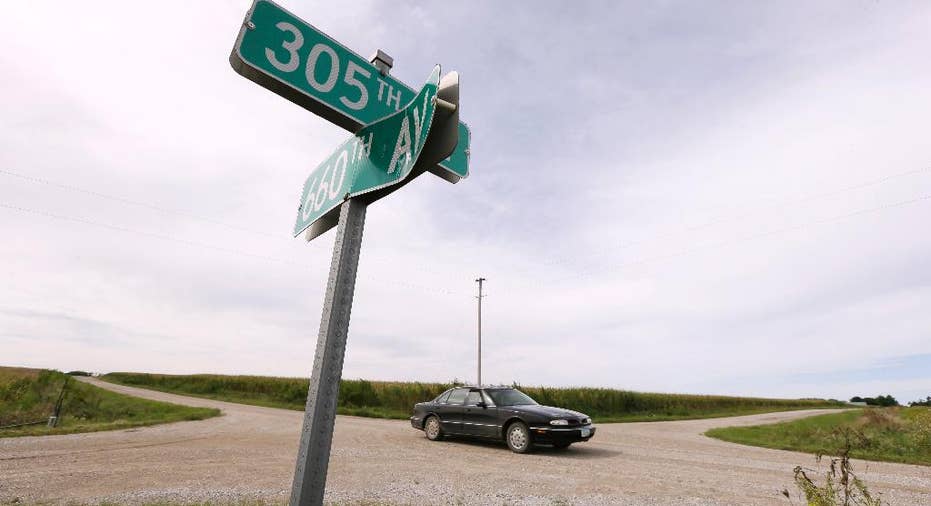In corn-growing states, tall crops pose a seasonal road hazard, sometimes lead to fatalities

The broad leaves and thick stalks can stand up to 12 feet high, forming a wall of foliage that turns rural roads into long, narrow corridors of nothing but corn.
For drivers navigating the gravel roads that crisscross Midwestern farm country, the plants go by in a noiseless blur of green, yellow and brown. But the annual crop brings an often-ignored danger: Some roads are so sheltered by the towering corn that motorists can't see each other until just before they collide, with potentially deadly results.
"There are so few people out driving, if you're a gambling person, the odds are it's not going to happen. But it only takes one time," said Dave Struthers, who grows corn and raises hogs near the small central Iowa city of Collins.
The peril is especially pervasive in Iowa, the nation's top corn producer, where crops are grown on more than 90 percent of the land and at least five people have been killed so far this season in crashes blamed on corn. Authorities issue regular warnings to the public, but generally they can do little more than plead with drivers to use caution.
The problem is also widespread across Illinois, Nebraska, Minnesota and Indiana. Each year, the risk climbs with the corn itself, beginning around mid-July, when the plants top 6 feet, and lasting until harvest in early October.
Key contributors are the sparse traffic and the lack of stop signs. For eight months a year, motorists can easily spot other vehicles or at least the plume of dust they stir up. Consequently, many drivers barely slow down when approaching intersections. And they often stick to that habit even as the corn grows taller, traveling 50 or 60 mph down the thin ribbons of gravel or pavement.
Two people died last summer in Iowa. In the past decade, there have been 28 to 51 crashes a year in which obstructions — primarily corn — have been a factor, according to the Iowa Transportation Department.
Struthers has been in two crashes in which he was surprised by a vehicle emerging from a dead-end dirt road onto the larger gravel road he was traveling. After the second time, he was thrown from his pickup and spent the night in a hospital.
"I remember seeing him, and the next thing I knew I was coming to in the ditch," Struthers said.
This year's Iowa crashes include the deaths of three brothers. The eldest, 16-year-old Jamie Singletary, was driving his two younger siblings, Carson and Christian, ages 13 and 10, to a football practice on Aug. 6, when their car collided at an unmarked intersection with a truck carrying rock to a construction site. Authorities said tall corn could have made it difficult for the boys to see the oncoming vehicle.
Another crash killed a woman in northeast Iowa, and an accident in central Iowa killed a father of five children.
"It's a tricky situation and an odd situation," said Steve Gent, who heads traffic and safety for the Iowa Department of Transportation.
Adding to the problem in recent years are improved seeds that let farmers plant their already dense fields even more tightly, resulting in an abundant crop but also creating a more impenetrable green wall, Gent said. The seeds are also drought tolerant, so even during dry summers, the plants flourish.
"It's taller. It's hardier. It's more lush," Gent said.
Roger Sy, a district director of the Illinois Corn Growers Association, recalled crashes happening not far from his farm near Newman, Illinois, including some in which teenagers have died. There will always be some people who travel too fast and don't stop at intersections, Sy said, but crashes tend to remind people to drive cautiously.
"It seems to leave a lasting impression for quite a while," Sy said.
Iowa, Illinois and Indiana occasionally try to focus attention on the problem with public information campaigns and by encouraging farmers not to plant too close to intersections and to trim stalks near roads later in the season.
Farmer Jeff Fisher said he does both at his farm near Tolono, Illinois. That can be costly, especially at a time when corn prices are low, but Fisher said he is vigilant.
"We wouldn't sacrifice safety," he said, "for a few bushels of corn."
___
Follow Scott McFetridge at: https://twitter.com/smcfetridge .